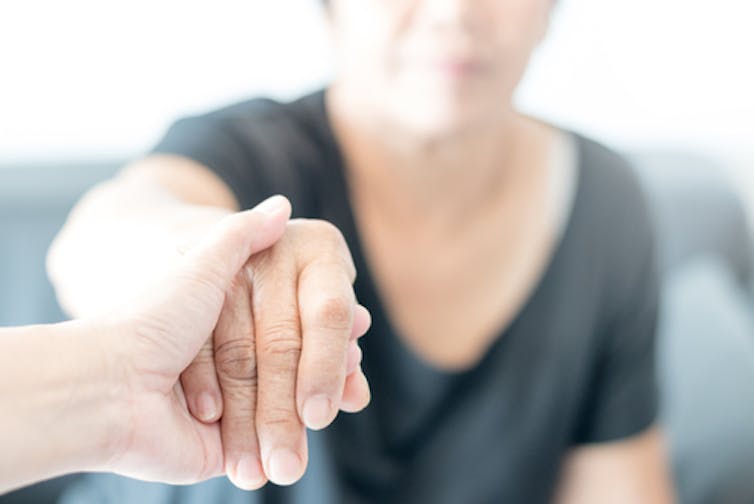 Other cultures view dementia differently. Could they help us be better caregivers? BlurryMe/Shutterstock.com
Other cultures view dementia differently. Could they help us be better caregivers? BlurryMe/Shutterstock.com
By Richard Gunderman and Lily Wolf, August 17, 2018
Picture two different families, each dealing with a diagnosis of dementia in one of its members. In one case, the patient is a retired executive, whose family tries as long as possible to keep the diagnosis secret, relying primarily on professional caregivers and eventually a nursing home. In another case, the patient is a grandmother. As soon as the diagnosis is suspected, her family pulls together, bringing her into their home and surrounding her with affection.
These two approaches to dementia reflect very different attitudes toward the disease. One regards it as an irreversible neurologic condition associated with considerable stigma, a problem best left to health professionals and kept out of public view. While not denying that dementia is a medical condition, the other seizes on it as an opportunity to draw together around a loved one in need, giving family members not a secret to keep but an opportunity to care.
A disease of patients and their families
Dementias touch many lives. For example, the most common dementia, Alzheimer’s disease, currently afflicts 5.7 million Americans and is expected to afflict 14 million by 2050. This increase partly mirrors population growth. But because risk increases with age, the rise also reflects our success in battling other causes of death, such as heart disease and stroke, enabling people to live longer. And the effects of the disease are not confined to patients; 16.1 million Americans now provide uncompensated care to dementia patients.
If you asked a physician to define dementia, most of us would probably describe it as a neurodegenerative disorder marked by declining cognitive abilities and memory. While this account is true as far as it goes, there is a problem: attacking most types of dementia as strictly biological entities has largely failed to advance our ability to diagnose and treat it. In the case of Alzheimer’s disease, definitive diagnosis still requires a biopsy, and new drugs to prevent, retard, or reverse it have proved disappointing.
A cultural perspective

Having a wide circle of friends throughout life may be an important part of dealing with dementia. Rawpixel/Shuttersock.com
Perhaps the time has come to expand our thinking about dementia to encompass not only cellular but cultural perspectives. Our society needs to recognize that dementia is not only a brain disorder of the person suffering from it but also a social disorder that can be understood in a variety of different ways. In other contexts, such disorders tend to be viewed in light of a larger circle of social relationships and cultural traditions. All generalizations must be qualified, but we have much to learn from other cultures.
In Japan, for example, to age well is not only to avoid contracting diseases but also to maintain a circle of family and friends right up to the moment when we breathe our last. Being of sound mind and body means continuing to exert ourselves both mentally and physically, remaining deeply invested in our personal relationships and receiving help from and helping others. So long as we continue to enrich others’ lives, we can remain “whole” in ways that exceed the mere absence of a medical diagnosis.
A large segment of traditional Chinese culture tends to see such matters similarly. Confucianism places a premium on family, and the decline of cognitive capacities of those who have led long and full lives can be seen not as the onset of a disease but as an opportunity for friends and family to express how much they care. Assuming increasing responsibility for an aging loved one represents an opportunity to show how strong the family really is.
The Hindu culture of India also prizes the opportunity to care for parents. What Americans tend to regard as a lamentable medical condition can be seen as a part of life’s natural cycle and the passage into a second childhood. The emphasis is not on the stigma of dementia, but rather on a withdrawal from worldly affairs to focus on other more essential matters. When an older person begins to show such signs, it is time for a natural transfer of authority to younger members of the family.
Seeing dementia anew
Viewing dementia from the standpoint of other cultures can help Americans see it with fresh eyes and re-pose fundamental questions that lie at its heart. What, for example, is a person, and how is personhood situated in the larger context of family and community? How does such a condition relate to what it means to be a good person and lead a good life? To what degree does dementia fracture us and what are the possibilities that it could bring us closer together?
The point of such a cultural approach is not to argue that biomedical accounts of dementia are fundamentally wrong. In virtually any disease state, but especially with a condition such as dementia, the experience of patients and families involves social, moral, and even spiritual perspectives, no less than biological ones. Perhaps because of our high regard for self-sufficiency and independence, dementia in the U.S. it tends to be relatively stigmatized.
Conceiving of dementia in different terms could offer new opportunities for prevention and treatment. Suppose, for example, that we Americans viewed it in terms similar to physical fitness. If we do not utilize our mental, physical, and social capacities, they will tend to dwindle – use it or lose it. On the other hand, if we remain active and challenged in each of these spheres, contributing where we can to enrich the lives of others, we can ease the strain of dementia in our lives.
To be sure, healthy neurons require adequate rest, nutrition, and even medical care. But the health of a person is more than the functioning of cells. People also need opportunities to put abilities to the test, connect with others, and lead lives that make a real contribution. If we tend not only to our neurons but also our intellects, characters, and relationships, there is good reason to think that we can lighten dementia’s burden and make the most of the opportunities to care for those living with it.
Richard Gunderman, Chancellor’s Professor of Medicine, Liberal Arts, and Philanthropy, Indiana University and Lily Wolf, Medical student, Indiana University School of Medicine
This article was originally published on The Conversation.
